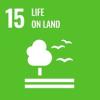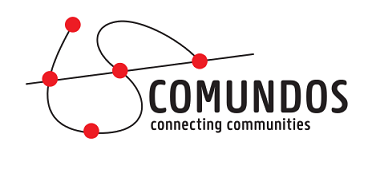SDG15 in the classroom: Life on land
“Sustainably manage forests, combat desertification, halt and reverse degradation, halt biodiversity loss”
After this lesson, the students will be able to:
- Understand the phenomena of land degradation, deforestation, erosion and biodiversity loss including their causes and consequences on humans and the planet
- Understand the practices of poaching and flora and fauna trafficking and its consequences
- Understand the values of composting
- Analyze digital stories on SDG15 by answering related questions
- Reflect on the story of Januario to identify and explain its metaphors
Students watch the story of Januario [A look from the Caatinga (Brazil)] to gain some first insights on SDG15. This video will be used also for activity 3 so it can be watched multiple times (if necessary).
Brainstorm session through the suggested questions:
- If we talk about SDG15- Life on land, to what other SDGs do you link it to? Why?
- What is soil? What are the benefits of productive soil?
- Who are the culprits of the phenomenon of land degradation1?
- Intensive livestock farming and unsustainable agriculture are some of the reasons behind deforestation. What are other reasons?
- Increased soil erosion (a gradual process of movement and transport of the upper layer of soil (topsoil) by different agents causing its deterioration in the long term) is one of the consequences of deforestation. Do you know other impacts of deforestation?
- Wildlife crime is a big business. Poaching and trafficking of flora and especially fauna is a huge problem that has to be halted. Do you know the risks of such practices? Regarding human health, think about the covid-19 pandemic and its origins, among other risks.
- The term “biodiversity” comes from “biological diversity”. In your words, define what biodiversity means and entails.
- Is the degradation of land related to biodiversity loss? Why/ Why not?
- What is the practice of “composting”? What are its benefits? Do you compost at home?
- We have the power to combat land degradation. Could you think of any solution?
(Online)This activity can be done with the use of online tools (i.e.Jamboard; Miro or Mentimeter).
1Notes for teachers: Land degradation (WHO) definition and more
Sustainable Development Goal 15 is about "Life on land". It is one of the 17 Sustainable Development Goals established by the United Nations in 2015. The official wording is: "Protect, restore and promote sustainable use of terrestrial ecosystems, sustainably manage forests, combat desertification, and halt and reverse land degradation and halt biodiversity loss".

The significance of forests, agricultural lands, and animals in our everyday existence cannot be overstated. Forests serve as homes for various wildlife, contribute to the food supply, and are integral to the water cycle. Farms and animals are not only a source of sustenance but also a means of livelihood. Animals play a vital role in maintaining the balance of ecosystems. Unfortunately, the threat of deforestation and land degradation poses a risk to these essential resources.
Students watch the following videos:
- Cerrado in gevaar (Brasilie)
- Palm Oil, a cancer for tropical woods (Guatemala)
- Het Belang van Agro-ecologie
Afterwards, they pick one video and explain:
- How it is related to SDG15
- The overall message the author wants to convey
- The lessons you learnt
Take this quiz (individually or the whole class as a group) to explore your knowledge and understanding of the world’s ecosystem. Ask students to share what they learnt.
Looking back at the story of Januario (Activity 1), students answer the following questions with a paragraph per each question:
Who is actually Januario? What is the metaphor in the story? Explain your answer.
The author talks about a “change of mentality”. In your opinion, what is he referring to? How do we change our mentality to achieve SDG15?
Possible adaptations: this activity can be done individually or in pairs.
This quiz is about UN Goal 15: Life on Land. You can either use it at the end of your lesson to revise the topics you have already talked about, or in the beggining of the lesson to challenge students prior knowledge and gain their attention.
For SDG15 (life on land) sheet, our favourite pedagogical twist is:
Make space for students' voices and knowledge sharing: Students’ tips. Before starting with the fist activity, ask students to give tips about a topic/SDG (for instance, a book/article to read, a video/series/movie/documentary to watch, a game to play, etc.) and ask them to give a little explanation of the proposed source (the main content, the author, where to find it, etc.). Create a shareable google spreadsheet where students can add the sources/link of their suggested material. Bear in mind: You can also learn from your students! If you have another pedagogical twist in mind, feel free to apply or check the pedagogical twist list.
- More information on SDG 15 and its targets by the Global Goals
- Land degradation documentary
- Elephant Poachers in Kenya explores the issues of elephant poachers in Kenya and the reasons behind this corrupted practice
Material to link to Activity 1.
- This video explains SDG15 and suggests actions people can take to help achieve this goal.
- Deforestation and forest degradation (WWF) focuses on the causes and impacts of these detrimental practices as well as actions WWF is taking to combat this problem.
- What is poaching? (WWF) focuses on the causes and impacts of wild animal poaching as well as actions WWF is taking to combat this problem.
- Illegal wildlife trade & zoonotic disease explains how illegal wildlife trade causes severe zoonotic diseases, presenting the case of the Covid-19 virus.

A gift for Comundos
Over the years, Comundos has helped remote communities around the world by teaching critical thinking, media literacy and the use of communication technology.
To do this effectively, we need your support for computers, translations, courses and social media management.
Thank you .
BE11 1030 2973 8248




